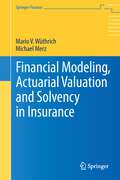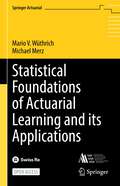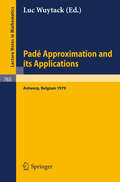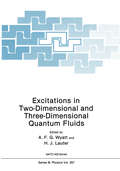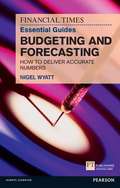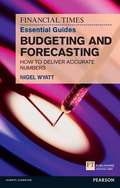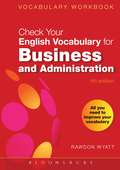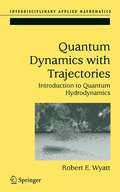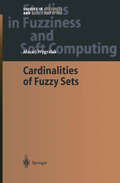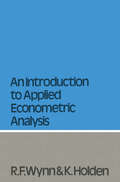- Table View
- List View
Market-Consistent Actuarial Valuation (EAA Series)
by Mario V. Wüthrich Hans Bühlmann Hansjörg FurrerIt is a challenging task to read the balance sheet of an insurance company. This derives from the fact that different positions are often measured by different yardsticks. Assets, for example, are mostly valued at market prices whereas liabilities are often measured by established actuarial methods. However, there is a general agreement that the balance sheet of an insurance company should be measured in a consistent way. Market-Consistent Actuarial Valuation presents powerful methods to measure liabilities and assets in a consistent way. The mathematical framework that leads to market-consistent values for insurance liabilities is explained in detail by the authors. Topics covered are stochastic discounting with deflators, valuation portfolio in life and non-life insurance, probability distortions, asset and liability management, financial risks, insurance technical risks, and solvency.
Market-Consistent Actuarial Valuation (EAA Series)
by Mario V. Wüthrich Hans Bühlmann Hansjörg FurrerIt is a challenging task to read the balance sheet of an insurance company since different positions are often measured by different yardsticks. Assets, for example, are mostly valued at market prices whereas liabilities are often measured by established actuarial methods. This book presents powerful methods to measure liabilities and assets in the same way. It explains the mathematical framework that leads to market-consistent values for insurance liabilities. Coverage includes stochastic discounting, valuation portfolio in life and non-life insurance, asset and liability management, financial risks, insurance technical risks, and solvency.
Financial Modeling, Actuarial Valuation and Solvency in Insurance (Springer Finance)
by Mario V. Wüthrich Michael MerzRisk management for financial institutions is one of the key topics the financial industry has to deal with. The present volume is a mathematically rigorous text on solvency modeling. Currently, there are many new developments in this area in the financial and insurance industry (Basel III and Solvency II), but none of these developments provides a fully consistent and comprehensive framework for the analysis of solvency questions. Merz and Wüthrich combine ideas from financial mathematics (no-arbitrage theory, equivalent martingale measure), actuarial sciences (insurance claims modeling, cash flow valuation) and economic theory (risk aversion, probability distortion) to provide a fully consistent framework. Within this framework they then study solvency questions in incomplete markets, analyze hedging risks, and study asset-and-liability management questions, as well as issues like the limited liability options, dividend to shareholder questions, the role of re-insurance, etc. This work embeds the solvency discussion (and long-term liabilities) into a scientific framework and is intended for researchers as well as practitioners in the financial and actuarial industry, especially those in charge of internal risk management systems. Readers should have a good background in probability theory and statistics, and should be familiar with popular distributions, stochastic processes, martingales, etc.
Statistical Foundations of Actuarial Learning and its Applications (Springer Actuarial)
by Mario V. Wüthrich Michael MerzThis open access book discusses the statistical modeling of insurance problems, a process which comprises data collection, data analysis and statistical model building to forecast insured events that may happen in the future. It presents the mathematical foundations behind these fundamental statistical concepts and how they can be applied in daily actuarial practice. Statistical modeling has a wide range of applications, and, depending on the application, the theoretical aspects may be weighted differently: here the main focus is on prediction rather than explanation. Starting with a presentation of state-of-the-art actuarial models, such as generalized linear models, the book then dives into modern machine learning tools such as neural networks and text recognition to improve predictive modeling with complex features. Providing practitioners with detailed guidance on how to apply machine learning methods to real-world data sets, and how to interpret the results without losing sight of the mathematical assumptions on which these methods are based, the book can serve as a modern basis for an actuarial education syllabus.
Queueing Theory and Network Applications: 12th International Conference, QTNA 2017, Qinhuangdao, China, August 21-23, 2017, Proceedings (Lecture Notes in Computer Science #10591)
by Wuyi Yue, Quan-Lin Li, Shunfu Jin and Zhanyou MaThis book constitutes the proceedings of the 12th International Conference on Queueing Theory and Network Applications, QTNA 2017, held in Qinhuangdao, China, in August 2017. The 19 full papers included in this volume were carefully reviewed and selected from 65 initial submissions. They deal with queueing models; queueing applications; and network models.
Pade Approximation and its Applications: Proceedings of a Conference held in Antwerp, Belgium, 1979 (Lecture Notes in Mathematics #765)
by L. WuytackExcitations in Two-Dimensional and Three-Dimensional Quantum Fluids (Nato Science Series B: #257)
by A. F. G. Wyatt H. J. LauterThe study of quantum fluids in three dimensions has been an important area for many years as it embraces Bose-Einstein condensation, superfluidity and macroscopic quantisation. These are fundamental aspects of physics which can be studied in liquid 4He. In contrast, quantum fluids in two dimension is more recent and less developed. Nevertheless it has shown many interesting phenomena including a rich variety of phases and the Kosterlitz-Thouless transition. Intermediate between these dimensions are the restricted geometries of micro porous materials into which He may be introduced. The main quantum materials considered are 4He, 3He, D2, H2, H and electrons on the surface of 4He. The superfluid phases of 3He were excluded, e~cept for superfluid film flow, as 3He involves a separate set of problems. These proceedings arise from a lively Advanced Research Workshop on Excitations in Two-Dimensional and Three-Dimensional Quantum Fluids held in Exeter 10-15 August 1990. Fifty scientists took part and each provided a written contribution. Perhaps it is a testimony to the discussions that several papers were revised by the authors after the meeting. The order of the chapters is the same as the presentations at the workshop. This arrangement starts with 4He in three dimensions which establishes a base from which the two dimensional properties can be viewed. At the end of each section there is a report on the discussion session. These are interesting and useful chapters as they clarify points made in the papers and define the boundary of current understanding.
The Financial Times Essential Guide to Budgeting and Forecasting: How to Deliver Accurate Numbers (The FT Guides)
by Nigel WyattGain the knowledge and confidence you need to build and manage budgets and forecast financial information. This book demystifies budgets and forecasts, providing simple explanations and clear examples. It includes integrated checklists, goals and milestones, to ensure you are on target to achieve the best results.Part of The Financial Times Essential Guides series: Task-focused and results-orientated, the essential guides are for every manager who wants to move their skills beyond the ordinary to the best.
The Financial Times Essential Guide to Budgeting and Forecasting: How to Deliver Accurate Numbers (The FT Guides)
by Nigel WyattGain the knowledge and confidence you need to build and manage budgets and forecast financial information. This book demystifies budgets and forecasts, providing simple explanations and clear examples. It includes integrated checklists, goals and milestones, to ensure you are on target to achieve the best results.Part of The Financial Times Essential Guides series: Task-focused and results-orientated, the essential guides are for every manager who wants to move their skills beyond the ordinary to the best.
Check Your English Vocabulary for Business and Administration: All you need to improve your vocabulary (Check Your Vocabulary)
by Rawdon WyattThis workbook provides a range of exercises to help learners of English at intermediate level and above learn and review essential vocabulary used in business and administration. It is particularly suitable for students or overseas-trained business and administration staff who want to work in an English-speaking country, or whose work brings them into regular contact with English-speaking business people. It is also ideal for students who are planning to take the BEC Vantage / Higher exam, the TOEIC or one of the LCCI International Qualifications.
Quantum Dynamics with Trajectories: Introduction to Quantum Hydrodynamics (Interdisciplinary Applied Mathematics #28)
by Robert E. WyattThis is a rapidly developing field to which the author is a leading contributor New methods in quantum dynamics and computational techniques, with applications to interesting physical problems, are brought together in this book Useful to both students and researchers
Logic - Language - Ontology: Selected Works (Studies in Universal Logic)
by Urszula B. Wybraniec-SkardowskaHow should we think about the meaning of the words that make up our language? How does reference of these terms work, and what is their referent when these are connected to abstract objects rather than to concrete ones? Can logic help to address these questions? This collection of papers aims to unify the questions of syntax and semantics of language, which span across the fields of logic, philosophy and ontology of language. The leading motif of the presented selection is the differentiation between linguistic tokens (material, concrete objects) on the one hand and linguistic types (ideal, abstract objects) on the other. Through a promenade among articles that span over all of the Author’s career, this book addresses the complex philosophical question of the ontology of language by following the crystalline conceptual tools offered by logic. At the core of Wybraniec-Skardowska’s scholarship is the idea that language is an ontological being, characterized in compliance with the logical conception of language proposed by Ajdukiewicz. The application throughout the book of tools of classical logic and set theory results fosters the emergence of a general formal logical theory of syntax, semantics and of the pragmatics of language, which takes into account the duality token-type in the understanding of linguistic expressions. Via a functional approach to language itself, logic appears as ontologically neutral with respect to existential assumptions relating to the nature of linguistic expressions and their extra-linguistic counterparts. The book is addressed to readers both at the graduate and undergraduate level, but also to a more general audience interested in getting a firmer grip on the interplay between reality and the language we use to describe and understand it.
Vaguely Defined Objects: Representations, Fuzzy Sets and Nonclassical Cardinality theory (Theory and Decision Library B #33)
by M. WygralakIn recent years, an impetuous development of new, unconventional theories, methods, techniques and technologies in computer and information sciences, systems analysis, decision-making and control, expert systems, data modelling, engineering, etc. , resulted in a considerable increase of interest in adequate mathematical description and analysis of objects, phenomena, and processes which are vague or imprecise by their very nature. Classical two-valued logic and the related notion of a set, together with its mathematical consequences, are then often inadequate or insufficient formal tools, and can even become useless for applications because of their (too) categorical character: 'true - false', 'belongs - does not belong', 'is - is not', 'black - white', '0 - 1', etc. This is why one replaces classical logic by various types of many-valued logics and, on the other hand, more general notions are introduced instead of or beside that of a set. Let us mention, for instance, fuzzy sets and derivative concepts, flou sets and twofold fuzzy sets, which have been created for different purposes as well as using distinct formal and informal motivations. A kind of numerical information concerning of 'how many' elements those objects are composed seems to be one of the simplest and more important types of information about them. To get it, one needs a suitable notion of cardinality and, moreover, a possibility to calculate with such cardinalities. Unfortunately, neither fuzzy sets nor the other nonclassical concepts have been equipped with a satisfactory (nonclassical) cardinality theory.
Cardinalities of Fuzzy Sets (Studies in Fuzziness and Soft Computing #118)
by Maciej WygralakCounting is one of the basic elementary mathematical activities. It comes with two complementary aspects: to determine the number of elements of a set - and to create an ordering between the objects of counting just by counting them over. For finite sets of objects these two aspects are realized by the same type of num bers: the natural numbers. That these complementary aspects of the counting pro cess may need different kinds of numbers becomes apparent if one extends the process of counting to infinite sets. As general tools to determine numbers of elements the cardinals have been created in set theory, and set theorists have in parallel created the ordinals to count over any set of objects. For both types of numbers it is not only counting they are used for, it is also the strongly related process of calculation - especially addition and, derived from it, multiplication and even exponentiation - which is based upon these numbers. For fuzzy sets the idea of counting, in both aspects, looses its naive foundation: because it is to a large extent founded upon of the idea that there is a clear distinc tion between those objects which have to be counted - and those ones which have to be neglected for the particular counting process.
Mathematical Methods for Physics: 45th anniversary edition
by H.W. Wyld Gary PowellFrom classical mechanics and classical electrodynamics to modern quantum mechanics many physical phenomena are formulated in terms of similar partial differential equations while boundary conditions determine the specifics of the problem. This 45th anniversary edition of the advanced book classic Mathematical Methods for Physics demonstrates how many physics problems resolve into similar inhomogeneous partial differential equations and the mathematical techniques for solving them. The text has three parts: Part I establishes solving the homogenous Laplace and Helmholtz equations in the three main coordinate systems, rectilinear, cylindrical, and spherical and develops the solution space for series solutions to the Sturm-Liouville equation, indicial relations, and the expansion of orthogonal functions including spherical harmonics and Fourier series, Bessel, and Spherical Bessel functions. Many examples with figures are provided including electrostatics, wave guides and resonant cavities, vibrations of membranes, heat flow, potential flow in fluids, and plane and spherical waves. In Part II the inhomogeneous equations are addressed where source terms are included for Poisson's equation, the wave equation, and the diffusion equation. Coverage includes many examples from averaging approaches for electrostatics and magnetostatics, from Green function solutions for time independent and time dependent problems, and from integral equation methods. In Part III complex variable techniques are presented for solving integral equations involving Cauchy Residue theory, contour methods, analytic continuation, and transforming the contour; for addressing dispersion relations; for revisiting special functions in the complex plane; and for transforms in the complex plane including Green’s functions and Laplace transforms. Key Features: · Mathematical Methods for Physics creates a strong, solid anchor of learning and is useful for reference. · Lecture note style suitable for advanced undergraduate and graduate students to learn many techniques for solving partial differential equations with boundary conditions · Many examples across various subjects of physics in classical mechanics, classical electrodynamics, and quantum mechanics · Updated typesetting and layout for improved clarity This book, in lecture note style with updated layout and typesetting, is suitable for advanced undergraduate, graduate students, and as a reference for researchers. It has been edited and carefully updated by Gary Powell.
Mathematical Methods for Physics: 45th anniversary edition
by H.W. Wyld Gary PowellFrom classical mechanics and classical electrodynamics to modern quantum mechanics many physical phenomena are formulated in terms of similar partial differential equations while boundary conditions determine the specifics of the problem. This 45th anniversary edition of the advanced book classic Mathematical Methods for Physics demonstrates how many physics problems resolve into similar inhomogeneous partial differential equations and the mathematical techniques for solving them. The text has three parts: Part I establishes solving the homogenous Laplace and Helmholtz equations in the three main coordinate systems, rectilinear, cylindrical, and spherical and develops the solution space for series solutions to the Sturm-Liouville equation, indicial relations, and the expansion of orthogonal functions including spherical harmonics and Fourier series, Bessel, and Spherical Bessel functions. Many examples with figures are provided including electrostatics, wave guides and resonant cavities, vibrations of membranes, heat flow, potential flow in fluids, and plane and spherical waves. In Part II the inhomogeneous equations are addressed where source terms are included for Poisson's equation, the wave equation, and the diffusion equation. Coverage includes many examples from averaging approaches for electrostatics and magnetostatics, from Green function solutions for time independent and time dependent problems, and from integral equation methods. In Part III complex variable techniques are presented for solving integral equations involving Cauchy Residue theory, contour methods, analytic continuation, and transforming the contour; for addressing dispersion relations; for revisiting special functions in the complex plane; and for transforms in the complex plane including Green’s functions and Laplace transforms. Key Features: · Mathematical Methods for Physics creates a strong, solid anchor of learning and is useful for reference. · Lecture note style suitable for advanced undergraduate and graduate students to learn many techniques for solving partial differential equations with boundary conditions · Many examples across various subjects of physics in classical mechanics, classical electrodynamics, and quantum mechanics · Updated typesetting and layout for improved clarity This book, in lecture note style with updated layout and typesetting, is suitable for advanced undergraduate, graduate students, and as a reference for researchers. It has been edited and carefully updated by Gary Powell.
Statistical Framework for Recreational Water Quality Criteria and Monitoring (Statistics in Practice #65)
by Larry J. WymerWith increasing rates of pollution to both land and aquatic environments, regulations for the quality of our waters are necessarily becoming more stringent. In the light of recent epidemiological studies new criteria are being established for the safety of our recreational waters. In order for such criteria to be developed an established statistical framework needs to be in place. Statistical Framework for Recreational Water Quality Criteria and Monitoring offers a practical guide to the statistical methods used for assessing health effects and monitoring and modelling water quality Both traditional and novel sampling designs are discussed. Written by a team of international experts in the field, this book sets out to provide an essential structure for the monitoring of water quality. · Proposes a much-needed framework for the monitoring of water quality, and provides practical guidance on the statistical methods involved. · Covers risk characterization, empirical modelling, sensitivity analysis and measures of robustness. · Details sampling methods and quality control approaches. · Presents crucial, real-life results from recent large-scale studies of water quality, central to the development of the area. · Accompanied by a supplementary website hosting data sets and tools for data analysis. The book is primarily aimed at public health officials, staff of regulatory bodies and students and faculty members of environmental and statistical science courses. There is also much to benefit readers from environmental research and risk analysis.
Network Synthesis Problems (Combinatorial Optimization #8)
by C. WynantsAs the telecommunication industry introduces new sophisticated technologies, the nature of services and the volume of demands have changed. Indeed, a broad range of new services for users appear, combining voice, data, graphics, video, etc. This implies new planning issues. Fiber transmission systems that can carry large amounts of data on a few strands of wire were introduced. These systems have such a large bandwidth that the failure of even a single transmission link: in the network can create a severe service loss to customers. Therefore, a very high level of service reliability is becoming imperative for both system users and service providers. Since equipment failures and accidents cannot be avoided entirely, networks have to be designed so as to "survive" failures. This is done by judiciously installing spare capacity over the network so that all traffic interrupted by a failure may be diverted around that failure by way of this spare or reserve capacity. This of course translates into huge investments for network operators. Designing such survivable networks while minimizing spare capacity costs is, not surprisingly, a major concern of operating companies which gives rise to very difficult combinatorial problems. In order to make telecommunication networks survivable, one can essentially use two different strategies: protection or restoration. The protection approach preas signs spare capacity to protect each element of the network independently, while the restoration approach spreads the redundant capacity over the whole network and uses it as required in order to restore the disrupted traffic.
Global and Organizational Discourse about Information Technology: IFIP TC8 / WG8.2 Working Conference on Global and Organizational Discourse about Information Technology December 12–14, 2002, Barcelona, Spain (IFIP Advances in Information and Communication Technology #110)
by Eleanor H. Wynn Edgar A. Whitley Michael D. Myers Janice I. DeGrossOver the past 20 years, the field of information systems has grown dramatically in theoretical diversity and global reach. This growth is reflected in the language that policy makers and organizational stakeholders use when they talk about their IT plans. As information technology penetrates further into organizational and global life, it becomes ever more important to articulate assumptions embedded in the discourse. This will help to clarify the complex and yet conceptually improvised or pasted-up worldview that becomes embodied in systems. The assumptions point to particular domains of discourse. The discourse sets up conventions and boundaries. It thus shapes what can or cannot legitimately be talked about, researched, addressed, or solved within the scope of IT. A number of practical and theoretical topics are discussed in detail, including: *Globalization, development, and space; *Mobilization of power; *ERP systems; *IS planning and projects; *Critical research and the study of discourse; *Public institutions; *Analytical frameworks. This book contains the selected proceedings of the Working Conference on Global and Organizational Discourse About Information Technology, sponsored by the International Federation for Information Processing (IFIP) and held in Barcelona, Spain in December 2002.
Do Not Erase: Mathematicians and Their Chalkboards
by Jessica WynneA photographic exploration of mathematicians’ chalkboards“A mathematician, like a painter or poet, is a maker of patterns,” wrote the British mathematician G. H. Hardy. In Do Not Erase, photographer Jessica Wynne presents remarkable examples of this idea through images of mathematicians’ chalkboards. While other fields have replaced chalkboards with whiteboards and digital presentations, mathematicians remain loyal to chalk for puzzling out their ideas and communicating their research. Wynne offers more than one hundred stunning photographs of these chalkboards, gathered from a diverse group of mathematicians around the world. The photographs are accompanied by essays from each mathematician, reflecting on their work and processes. Together, pictures and words provide an illuminating meditation on the unique relationships among mathematics, art, and creativity.The mathematicians featured in this collection comprise exciting new voices alongside established figures, including Sun-Yung Alice Chang, Alain Connes, Misha Gromov, Andre Neves, Kasso Okoudjou, Peter Shor, Christina Sormani, Terence Tao, Claire Voisin, and many others. The companion essays give insights into how the chalkboard serves as a special medium for mathematical expression. The volume also includes an introduction by the author, an afterword by New Yorker writer Alec Wilkinson, and biographical information for each contributor.Do Not Erase is a testament to the myriad ways that mathematicians use their chalkboards to reveal the conceptual and visual beauty of their discipline—shapes, figures, formulas, and conjectures created through imagination, argument, and speculation.
Do Not Erase: Mathematicians and Their Chalkboards
by Jessica WynneA photographic exploration of mathematicians’ chalkboards“A mathematician, like a painter or poet, is a maker of patterns,” wrote the British mathematician G. H. Hardy. In Do Not Erase, photographer Jessica Wynne presents remarkable examples of this idea through images of mathematicians’ chalkboards. While other fields have replaced chalkboards with whiteboards and digital presentations, mathematicians remain loyal to chalk for puzzling out their ideas and communicating their research. Wynne offers more than one hundred stunning photographs of these chalkboards, gathered from a diverse group of mathematicians around the world. The photographs are accompanied by essays from each mathematician, reflecting on their work and processes. Together, pictures and words provide an illuminating meditation on the unique relationships among mathematics, art, and creativity.The mathematicians featured in this collection comprise exciting new voices alongside established figures, including Sun-Yung Alice Chang, Alain Connes, Misha Gromov, Andre Neves, Kasso Okoudjou, Peter Shor, Christina Sormani, Terence Tao, Claire Voisin, and many others. The companion essays give insights into how the chalkboard serves as a special medium for mathematical expression. The volume also includes an introduction by the author, an afterword by New Yorker writer Alec Wilkinson, and biographical information for each contributor.Do Not Erase is a testament to the myriad ways that mathematicians use their chalkboards to reveal the conceptual and visual beauty of their discipline—shapes, figures, formulas, and conjectures created through imagination, argument, and speculation.
Parallel Processing and Applied Mathematics: 7th International Conference, PPAM 2007, Gdansk, Poland, September 9-12, 2007, Revised Selected papers (Lecture Notes in Computer Science #4967)
by Roman Wyrzykowski Jack Dongarra Konrad Karczewski Jerzy WasniewskiThis book constitutes the thoroughly refereed post-conference proceedings of the 7th International Conference on Parallel Processing and Applied Mathematics, PPAM 2007, held in Gdansk, Poland, in September 2007. The 63 revised full papers of the main conference presented together with 85 revised workshop papers were carefully reviewed and selected from over 250 initial submissions. The papers are organized in topical sections on parallel/distributed architectures and mobile computing, numerical algorithms and parallel numerics, parallel and distributed non-numerical algorithms, environments and tools for as well as applications of parallel/distributed/grid computing, evolutionary computing, meta-heuristics and neural networks. The volume proceeds with the outcome of 11 workshops and minisymposia dealing with novel data formats and algorithms for dense linear algebra computations, combinatorial tools for parallel sparse matrix computations, grid applications and middleware, large scale computations on grids, models, algorithms and methodologies for grid-enabled computing environments, scheduling for parallel computing, language-based parallel programming models, performance evaluation of parallel applications on large-scale systems, parallel computational biology, high performance computing for engineering applications, and the minisymposium on interval analysis.
Parallel Processing and Applied Mathematics: 5th International Conference, PPAM 2003, Czestochowa, Poland, September 7-10, 2003. Revised Papers (Lecture Notes in Computer Science #3019)
by Roman Wyrzykowski Jack Dongarra Marcin Paprzycki Jerzy WasniewskiIt is our pleasure to provide you with the volume containing the proceedings of the 5th International Conference on Parallel Processing and Applied Mathe- tics, which was held in Cz¸ estochowa, a Polish city famous for its Jasna Gora Monastery, on September 7–10, 2003. The ?rst PPAM conference was held in 1994 and was organized by the Institute of Mathematics and Computer Science of the Cz¸ estochowa University of Technology in its hometown. The main idea behind the event was to provide a forum for researchers involved in applied and computational mathematics and parallel computing to exchange ideas in a relaxed atmosphere. Conference organizers hoped that this arrangement would result in cross-pollination and lead to successful research collaborations. In - dition, they hoped that the initially mostly Polish conference would grow into an international event. The fact that these assumptions were correct was proven by the growth of the event. While the ?rst conference consisted of 41 presen- tions, the conference reached 150 participants in Na l¸ ecz´ ow in 2001. In this way the PPAM conference has become one of the premiere Polish conferences, and de?nitely the most important one in the area of parallel/distributed computing andappliedmathematics. This year’s meeting gathered almost 200 participants from 32 countries. A strict refereeing process resulted in the acceptance of approximately 150 cont- buted presentations, while the rejection rate was approximately 33%.


